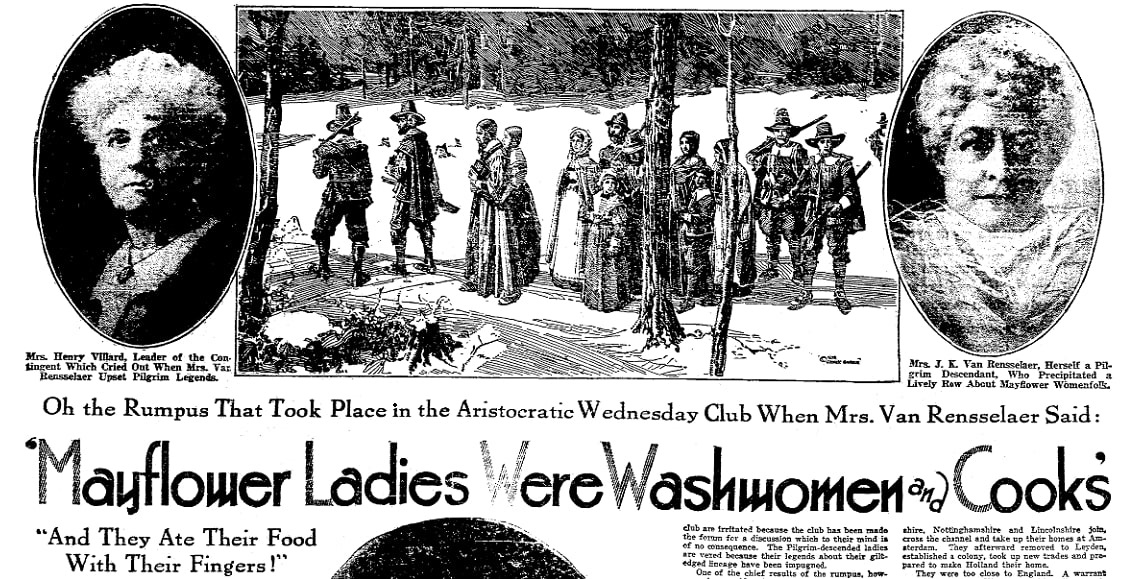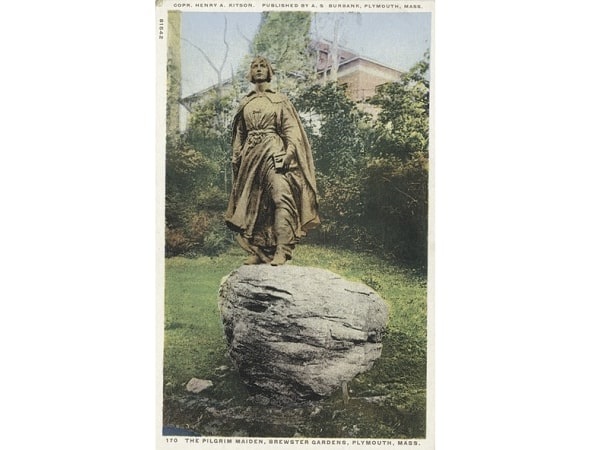Introduction: In this article, Melissa Davenport Berry concludes her story about a dispute that broke out at an aristocratic luncheon when a grande dame insulted the women of the Mayflower. Melissa is a genealogist who has a blog, AnceStory Archives, and a Facebook group, New England Family Genealogy and History.
Today I conclude my article about the cat fight that broke out at the Wednesday Club women’s group in New York in 1922 (see Mayflower Descendants: Who’s Who, Part VII). The luncheon ladies sparred with Mrs. J. K. Van Rensselaer, aka “Tyrannical Empress of America,” after she declared: “Mayflower ladies were washerwomen and cooks.”

The squabble spiraled into “volcanic intensity” when she inferred the Pilgrims were common ruffians who ate their food with their fingers! Van Rensselaer caused quite a rumpus, but this got the luncheon ladies vested in the history of their Pilgrim ancestors by reading accounts like Edmund James Carpenter’s book The Mayflower Pilgrims. The San Diego Union reported on the incident.

As this article reported:
“An examination of the recovered manuscript of Gov. Bradford revealed that the Pilgrims were of the company of religionists called Separatists and that they had their origin in ‘sundrie towns and villages, some in Nottinghamshire, some of Lincolnshire.’
“William Brewster, leader of the Separatist movement, was of aristocratic family and university bred, as was his young lieutenant, Bradford. Their followers were for the most part humble folk. They were husbandmen in the fields, keepers of the flocks in the villages, or small artisans.”
I add to the list Richard More, a product of two semi-aristocratic families. Also of the educated and prominent class were passengers Samuel Fuller and Edward Winslow.
This article also reported:
“Brewster, in his young manhood, was a secretary to William Davison, who was an under-secretary of state to Queen Elizabeth. The Queen’s duplicity toward Davison is well known.”
In a nutshell: the Queen used Davison as a scapegoat to off her cousin Mary, the Scottish queen. Although Elizabeth signed the death order, she had Davion deliver it. Afterward, she accused him of having “exceeded his instructions” and removed him from office. Brewster fell with Davison and was banished from the royal court.
Another tidbit: Brewster also began operating a printing press, located in Choir Alley, to pick up some extra coin. The Library of the Pilgrim Society contains several “Pilgrim Press” books, available to scholarly researchers by appointment. A small selection of the Pilgrim Press books is always on display in Pilgrim Hall Museum, 75 Court Street, Plymouth, MA.
This article further reported:
“[Brewster] became the leader of the religious movement which later resulted in the Pilgrim migration and final settlement at Plymouth.”
The Mayflower set sail for the New World with 102 passengers and landed on Cape Cod in December 1620.
I found an article in the Boston Herald published in 1909 entitled “Who-Was-Who and What-Was-What on Voyage of the Mayflower in 1620.” At that time, Boston was gearing up for the 1920 Pilgrim Tercentennial.
This article began:
“The great test of the fibre of the Pilgrim Fathers came after their farewell to England, their 10 years in Holland and their voyage across the sea. The voyage itself is a romantic story of a daring venture. But it was in the months that stretched from Nov. 20, 1620, when they sighted land, to April 15, 1621, when the Mayflower got under way for the voyage back to England, that they were subjected to the stern experiences that proved their worthiness to establish a colony whose history should become one of the most potent influences in the American nation.”
The Pilgrims were not just survivors, they were thrivers!
This next article praised the women of the Mayflower.
The women on the Mayflower were courageous and quite amazing. And Madam Van Rensselaer, along with her society minions, would not have lasted a second on the journey across the Atlantic or in the New World. The stouthearted ladies of the Mayflower are to be commended for their bravery and tenacity even if they ate with their fingers and washed their own bowls!
Note: An online collection of newspapers, such as GenealogyBank’s Historical Newspaper Archives, is not only a great way to learn about the lives of your ancestors – the old newspaper articles also help you understand American history and the times your ancestors lived in, and the news they talked about and read in their local papers. Do you have a connection all the way back to the Mayflower Pilgrims?
